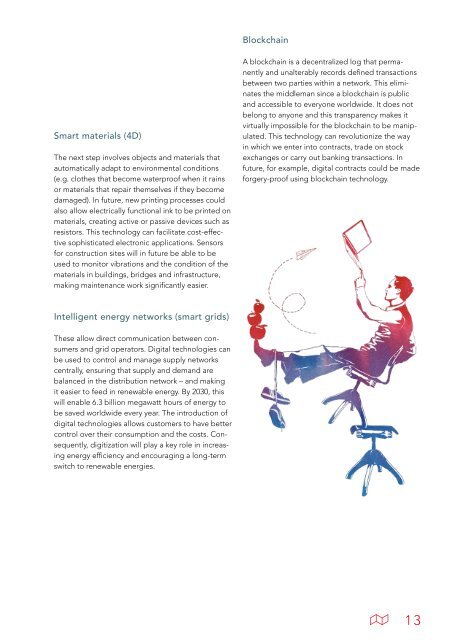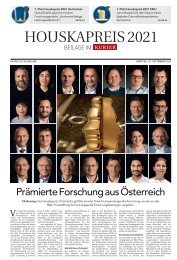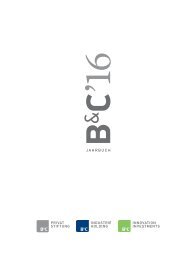Digital Roadmap Austria english
You also want an ePaper? Increase the reach of your titles
YUMPU automatically turns print PDFs into web optimized ePapers that Google loves.
Blockchain<br />
Smart materials (4D)<br />
The next step involves objects and materials that<br />
automatically adapt to environmental conditions<br />
(e.g. clothes that become waterproof when it rains<br />
or materials that repair themselves if they become<br />
damaged). In future, new printing processes could<br />
also allow electrically functional ink to be printed on<br />
materials, creating active or passive devices such as<br />
resistors. This technology can facilitate cost-effective<br />
sophisticated electronic applications. Sensors<br />
for construction sites will in future be able to be<br />
used to monitor vibrations and the condition of the<br />
materials in buildings, bridges and infrastructure,<br />
making maintenance work significantly easier.<br />
A blockchain is a decentralized log that permanently<br />
and unalterably records defined transactions<br />
between two parties within a network. This eliminates<br />
the middleman since a blockchain is public<br />
and accessible to everyone worldwide. It does not<br />
belong to anyone and this transparency makes it<br />
virtually impossible for the blockchain to be manipulated.<br />
This technology can revolutionize the way<br />
in which we enter into contracts, trade on stock<br />
exchanges or carry out banking transactions. In<br />
future, for example, digital contracts could be made<br />
forgery-proof using blockchain technology.<br />
Intelligent energy networks (smart grids)<br />
These allow direct communication between consumers<br />
and grid operators. <strong>Digital</strong> technologies can<br />
be used to control and manage supply networks<br />
centrally, ensuring that supply and demand are<br />
balanced in the distribution network – and making<br />
it easier to feed in renewable energy. By 2030, this<br />
will enable 6.3 billion megawatt hours of energy to<br />
be saved worldwide every year. The introduction of<br />
digital technologies allows customers to have better<br />
control over their consumption and the costs. Consequently,<br />
digitization will play a key role in increasing<br />
energy efficiency and encouraging a long-term<br />
switch to renewable energies.<br />
13
















